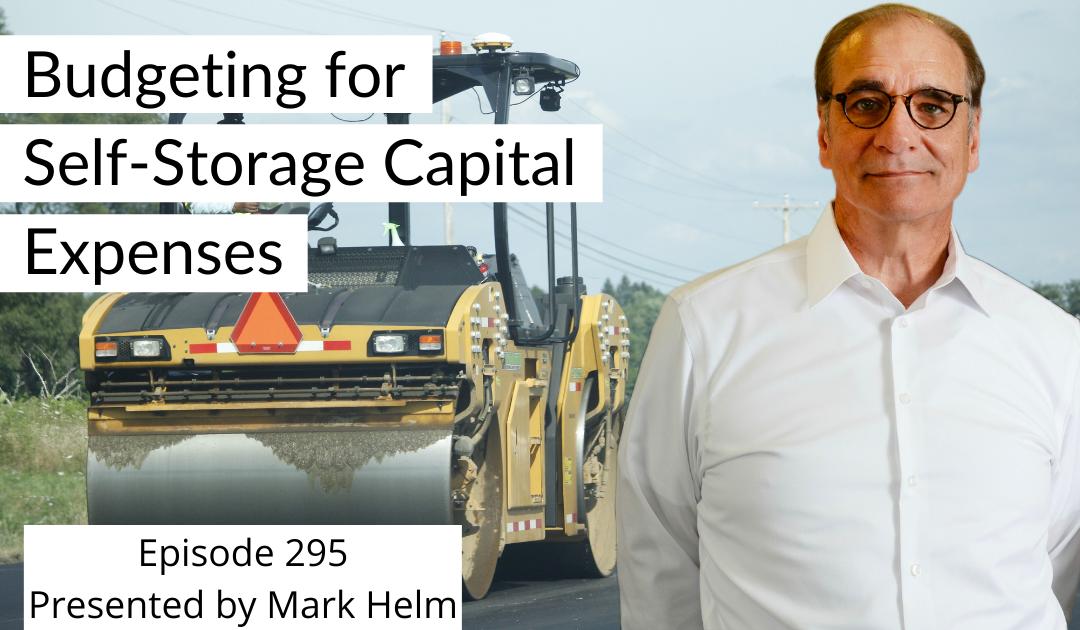If you are considering getting into the self-storage business or in the self-storage business, one of the attractive features is the low amount of ongoing capital expenses.
Unlike multi-family, office, or even retail, there are very few capital expenses required to keep the operating cash flow going.
There are no commissions, no tenant improvements, no appliances required. You don’t even need a vanilla box as is required in retail. For the most part, steel walls and concrete floor. Period.
While self-storage capital expenses are low, you should still maintain a budget for some items.
This is not a complicated process, but with a proper budget/reserves set aside, one can rarely, or even never, have to tap into operating cash flow to pay anything other than the loan payment and the modest reserve fund for the capital expenses.
We had a $60,000 sign blow down in a storm (OK, we did upgrade it with LED), and because of the modest reserve fund, the month we paid the $10,000 insurance deductible, we didn’t miss a penny in monthly distributions because of the fund.
Items on the Budget
In the self-storage world, assuming you have a normal, fabricated self-storage system, there will be some ongoing depreciating capital assets that will need upgrading and replacement along the way.
These include items such as:
- HVAC in the office and climate-controlled areas.
- The office/retail area of the facility.
- Gates and gate controls.
- Security systems.
- Paving and blacktopping periodically.
- Unit doors as needed.
- Re-graveling if areas are unpaved.
- Repairs to buildings and fencing from customers and trucks.
These are just some of the basics.
How to Budget
For us, the capital expenditure budgeting process starts during the due- diligence inspections.
We see the life expectancy for the major mechanicals, what condition the unit doors are in, roof systems, etc. How much will re-paving cost? When will the next one be required? How many HVAC units are there? What is the life expectancy left of each one?
At the end of the due diligence period, we have our estimated capital expense budget and approximately when we will need it.
We then come up with a yearly amount that we want to hold back.
Sometimes we need to pre-fund the capital reserve fund. If we are doing an expansion or planned upgrades where we are borrowing some or all of the funds, we can include year one capital expenses in the construction budget.
I will leave that up to you.
Mostly, we start putting the reserve fund aside monthly, as described below.
If it is a lease-up situation, we usually start setting aside the reserve fund when we hit profitability (i.e., operating expenses and loan payments are being paid out of operating cash flow), or at least by stabilization.
Shortcut
I love shortcuts, and here is one concerning budgeting the capital expense reserve fund.
We learned this over the years and from conduit lenders as we began using that loan option because they require a capital reserve to be set aside, and they manage it. They usually use a per square foot per year number as stated below.
We also began to see that depending on the condition of the facility, our reserve fund budget usually came out to 12 cents per square foot up to 15 cents per square foot.
The older the facility and one with more deferred maintenance, the closer to the 15 cent number. Newer, more well-kept, towards the lower number.
An interesting side note, our reserve fund budget is almost exactly what our yearly repair and maintenance number come out to be.
We literally set up a separate account where we put the reserve fund and one-twelfth of the property taxes aside every month for our stabilized facilities. We set this aside before any partner distributions.
Here is what we see. Once we have a year or so reserve funds set up, we virtually never have to dip into operating cash flow for capital expenses.
It also helps keep our insurance cost lower. We can go for higher deductibles because we know we have reserve funds set aside. We usually select the highest deductible offered.
Conclusion
One of the best things about self-storage is the predictability of the cash flows. You can do this better with self-storage than any other real estate asset class.
However, it starts here with your capital reserve fund budget and set up to do this. It will be rare indeed if you ever have to dip into operating cash flow for capital expenditures. It is not hard to do. Set it up and fund it monthly or however you budget to do it.
By having the discipline to do this, you are increasing the probability of hitting your projected cash flows and keeping the ongoing value of your facility as high as possible.
The process isn’t complicated. It just requires a little discipline. If you have read this far, then you are one of the people who have that discipline.



